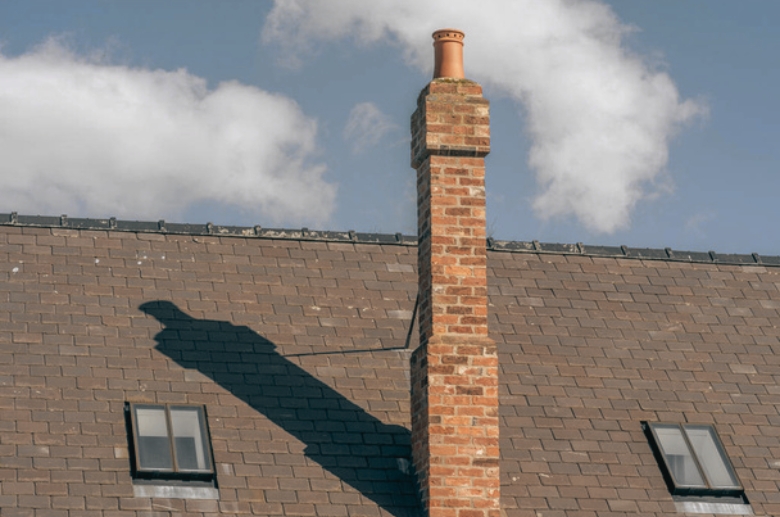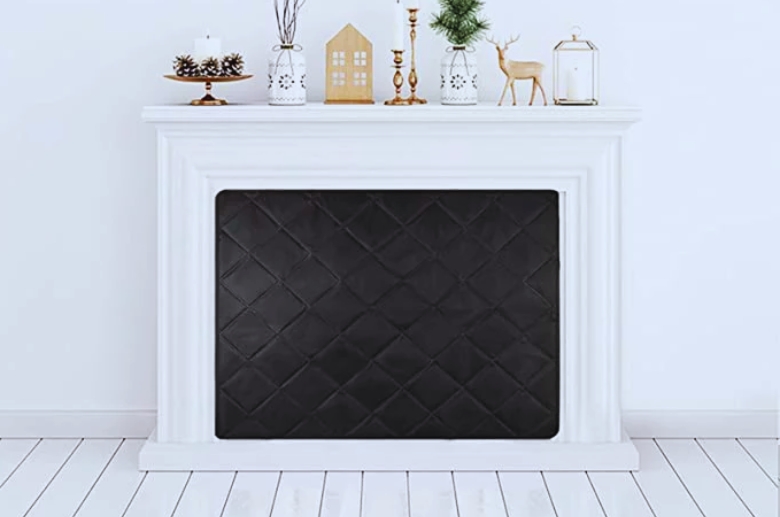A drafty fireplace can be a significant source of discomfort and energy inefficiency in your home. If you’ve noticed cold air coming in through the fireplace, struggled to light a fire, or even had smoke backdraft into the room, addressing this issue is essential.

Research indicates that up to 8% of indoor air leaks can occur through fireplaces, significantly impacting your home’s energy efficiency.
In this guide, we’ll explore why fireplaces can be drafty, how to identify the signs, traditional methods for stopping drafts, and, most importantly, how to cover a drafty fireplace. By the end, you’ll understand how to keep your home cozy and energy-efficient.
——
Do You Need to Hire Chimney & Fireplace Expert?
Get free quotes from qualified experts near you. No commitment required!
——
Why Fireplaces Can Be Drafty
Drafty fireplaces can be caused by many factors, including an improperly sized flue, a damaged chimney, a blocked chimney, or a poorly sealed fireplace. Factors influencing drafts include:

- Air Leaks: Gaps or openings in the fireplace area, chimney, roof, or damper can allow cold air to enter and warm air to escape.
- Chimney Height: The height of your chimney can affect its ability to draft correctly. A chimney that is too short or not properly sized may not draw air effectively, causing draft issues.
- Flue Size: Insufficient drafting may arise if the chimney flue is disproportionately small compared to the fireplace opening and hearth size.
- Negative Air Pressure: Negative air pressure, a situation where the air pressure inside a space is lower than the pressure outside, can cause air to be pulled down the chimney, leading to drafts.
Addressing these issues ensures your fireplace functions efficiently and keeps your home warm.
How to Identify a Drafty Fireplace
To identify a drafty fireplace, look for these signs:

- Smoke Backdraft: If you notice smoke entering the room when starting a fire, it’s a clear sign of a draft problem.
- Difficulty Lighting a Fire: If you struggle to get a fire going, it might be due to a poor draft.
- Cold Air Detection: Feeling cold air around the fireplace can reveal leakages.
- Damper Inspection: A damper inspection helps pinpoint areas where cold air might be entering or warm air escaping, allowing for necessary adjustments to improve energy efficiency.
- Examination of Fireplace Doors and Firebox: Inspect these areas for gaps or wear and measure the dimensions of the fireplace opening, which is usually 24-36 inches in width, 24-29 inches in height, and 16 inches in depth.
- Chimney Structural Check: Look for signs of wear or structural problems such as mortar degradation, brickwork damage, and potential cracks or fractures and understand the role of the chimney in regulating drafts.
You can use a chimney backdraft calculator to effectively measure whether your chimney has a backdraft.
Traditional Methods for Stopping Drafts
After identifying if you have a drafty fireplace, you can use traditional methods to stop fireplace draft, including:
1. Chimney Cleaning:
Pros:
- Improved Efficiency: Regular cleaning eliminates creosote buildup, which can obstruct airflow and reduce efficiency.
- Reduced Fire Hazard: Cleaning lowers the risk of chimney fires caused by creosote ignition.
Cons:
- Maintenance: It requires regular upkeep.
- Cleaning Costs: Hiring a professional chimney sweep may come with an estimated price of around $250.
2. Chimney Cap or Damper Installation:
Pros:
- Draft Prevention: Caps and dampers help prevent drafts and air leaks.
- Improved Energy Efficiency: They reduce energy loss for your property.
Cons:
- Installation: You may need professional installation by a chimney company with an average cost of $200 to $500.
- Initial Cost: There’s an upfront cost for purchasing and setting up everything. Depending on the contractor or business, the usual quote ranges from $85 to $130.
3. Air Leak Sealing:
Pros:
- Effective Draft Reduction: Sealing gaps and openings can reduce drafts.
- Improved Efficiency: Enhanced energy efficiency by preventing cold air infiltration.
Cons:
- Labor-Intensive: Locating and sealing gaps in the building can require intense labor, especially in older fireplaces.
- Aesthetic Impact: Depending on the sealing method and product used, the process may affect the fireplace’s aesthetics.
These traditional methods are tried and tested for addressing drafty fireplaces. However, they may have limitations, such as ongoing maintenance requirements, installation costs, or aesthetic considerations. The choice of method depends on your specific needs and circumstances.
——
Do You Need to Hire Chimney & Fireplace Expert?
Get free quotes from qualified experts near you. No commitment required!
——
How to Cover a Drafty Fireplace
Before starting your DIY project, here’s a list of tools and materials that you need.
| Category | Equipment/Tool |
| Safety Equipment | Safety glasses, dust mask |
| Climbing and Access | Extension ladder |
| Power Tools | Cordless drill with a screwdriver bit |
| Cleaning | Vacuum, chimney brushes, fiberglass extension rods |
| Illumination | Flashlight |
| Additional tools | Sheet plastic, painter’s tape, measuring tape, and duct tape |
Here’s a step-by-step guide for installing these covers if you’re going to do the DIY job.

Magnetic Covers
Step 1: Clean the inside surface of the fireplace surround with your chimney brush to ensure good adhesion.
Step 2: Position the magnetic cover over the fireplace opening.
Step 3: Press it against the fireplace surround to create a seal.
Step 4: Ensure there are no gaps or spaces where cold air can enter. Use your flashlight for hard-to-see corners.
Step 5: Remove the cover and store it when not in use.
Inflatable Covers (Chimney Balloons)
Step 1: Measure the dimensions of your fireplace opening with your measuring tape.
Step 2: Purchase a chimney balloon that matches these measurements.
Step 3: Inflate the chimney balloon with the provided inflation tube.
Step 4: Insert the inflated balloon into the fireplace opening.
Step 5: Adjust the balloon until it creates a snug seal.
Step 6: Remember to remove and deflate the balloon before starting a fire.
Fabric Covers
Step 1: Measure your fireplace opening using a measuring tape.
Step 2: Choose a fabric cover that matches these measurements.
Step 3: Insert the cover into the fireplace opening.
Step 4: Make sure it fits snugly, covering any gaps or leaks.
Step 5: Some fabric covers have added methods, such as straps or clips, to keep them in place. You can also use tape to temporarily hold it in place while maneuvering it to the final position.
Step 6: When not in use, remove the fabric cover and store it as needed.
Each of these methods can effectively stop drafts and keep your home cozy. The choice of cover depends on your specific preferences and priorities, whether that’s ease of use, aesthetics, or long-term durability.
Should You Cover a Drafty Fireplace?
Deciding whether to cover your drafty fireplace involves considering several factors. These include the frequency of fireplace use, aesthetic preferences, and safety concerns.
Here are the pros and cons of covering a drafty fireplace.
Pros:
- Draft Elimination: It creates a physical barrier that stops cold air from infiltrating your home.
- Energy Efficiency: According to the U.S. Department of Energy, using a fireplace cover can reduce heat loss through the fireplace by up to 90%.
- Safety Enhancement: Fireplace covers can reduce the risk of house fires by preventing sparks and embers from escaping the fireplace.
- Aesthetic Benefits: Covers come in various designs, materials, and finishes, allowing you to color-complement your mantle.
- A Quieter Home: Fireplace covers can reduce the noise coming from the fireplace.
Cons:
- Reduced Usability: You can’t use the fireplace safely while a cover is in place.
- Aesthetic Impact: While some covers enhance aesthetics, others might not align with your interior design preferences.
- Ventilation issues: Covering the fireplace can affect room ventilation and might become an issue if the fireplace is your primary source of ventilation or you have concerns about air quality.
Conclusion
Addressing drafty fireplaces enhances comfort, energy efficiency, and safety. Recognizing symptoms like cold air seepage or smoke issues is crucial.
While traditional methods such as cleaning and installing chimney caps work, alternatives like repairs or damper installation offer effective solutions.
Choose based on your needs. Don’t let drafts diminish your fireplace’s charm. Act now and call a professional chimney technician for warmth and savings. Your future self will thank you.
FAQs
Here are frequently asked questions from homeowners regarding cold drafts and fireplace vent covers.
Do fireplace screens help with drafts?
Yes, fireplace screens help with drafts by preventing cold air from entering the room and containing sparks. They act as a barrier, improving both safety and energy efficiency.
How often should you inspect your fireplace for draft issues?
Inspect your fireplace for draft issues annually, preferably before the heating season, to ensure optimal performance.
Are there any risks to using magnets for fireplace covers?
Yes, using magnets for fireplace covers can be risky as they may interfere with electronic components and appliances. This increases the potential for melting if the cover is exposed to a burning fire, leading to a hazardous gas buildup and trim damage.






